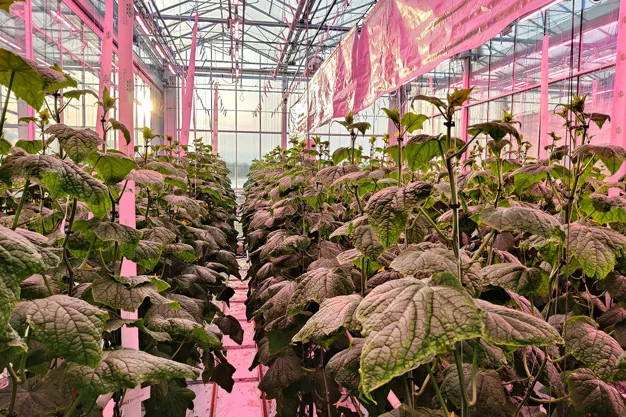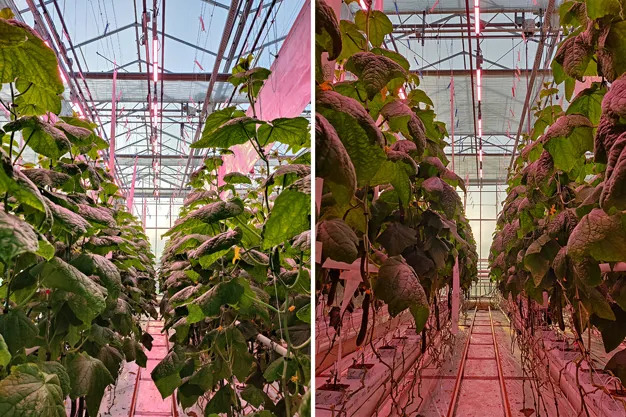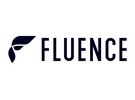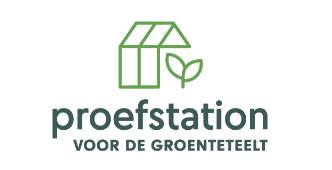The development of lighting in cucumber has seen significant advancements over the last couple of years. Similar to other crops, the possibility to steer upon a certain spectrum enabled researchers to dive into the susceptibility of a crop for a certain spectrum. Sebastian Olschowski with Fluence and Jari van Dam with Proefstation voor de Groenteteelt share their latest insights, focusing specifically on the use of far-red in cucumber cultivation.
 The trial with far-red at the Proefstation voor de Groenteteelt
The trial with far-red at the Proefstation voor de Groenteteelt
From lux to PAR
When talking about light in past decades, growers were mostly exposed to terms like watt, lux, lumen or candela, those metrics reflect the brightness impression of humans. Plants use light for photosynthesis primarily in the wavelength range of 400-700 nm. This range is called Photosynthetic Active Radiation (PAR). Beyond PAR light, there are other wavelengths, such as far-red, which affect plant growth. Far-red wavelengths typically are in the range between 700 and 800 nm and have unique effects on the physiological processes in plants. The role of far-red in cucumber production is gaining more attention due to its potential impact on plant development and productivity, says Sebastian Olschowski.
"In our previous research projects, we've seen effects of various spectral compositions. We've found that cucumbers can benefit from energy-efficient spectra, but they still need the full range of wavelengths to achieve optimal morphology and yield. Manipulating the spectrum towards those two factors will become even more important for the future, especially for different cultivars", says Sebastian when asked about optimum light efficiency in cucumber crops. As the Project Manager of Fluence, he is always on the lookout for new insights into the effects of light on crop development. That is where the Led FR project is coming into the game. This four-year agricultural initiative is funded by VLAIO (Agency for Innovation & Entrepreneurship) in Flanders, conducting experiments with far-red on cucumber, tomato, and lettuce crops.
Different plant processes
"Phytochromes capture red and far-red light, and depending on the ratio between them, they trigger different plant processes," Jari explains. "In cucumber cultivation, an increase in far-red light primarily results in the elongation of various plant parts. The plant becomes taller, the petioles lengthen, and the fruit stems also grow longer. Additionally, the leaves tend to stretch more horizontally, creating a larger light-intercepting surface. This leads to a more open crop, making crop management and harvesting easier.
In the currently running third year, the Led FR consortium advanced to a more dynamic control with far-red light, aiming to achieve the same effects as a static far-red treatment but with less far-red light, making it more efficient. "When considering cucumber cultivation under artificial lighting in the darkest months, far-red light appears to be crucial in the months from November to January, gradually decreasing in importance in February," says Jari. "The industry seems to recognize this trend. There is still untapped potential in optimizing the use of far-red light as efficiently as possible. Determining when far-red light is necessary and at what level of natural sunlight it can be switched off.
 Left: with far red, right: without
Left: with far red, right: without
Different supplemental light treatments
The experiment consists of four different supplemental light treatments, where the number of photons is kept the same at all times. This was requested by collaborating growers and partners says Jari. Two of the treatments are static, meaning PAR light and far-red are not changing during the photoperiod.
Two other treatments are dynamically applied to the plants, where PAR light is reduced while far-red light is increased, or the opposite to keep the number of photons at the same level, resulting in the following treatments:
- Static without far-red (control)
- Static with far-red (R : FR – 6 : 1 ratio)
- Dynamic pulsating far-red for 20 minutes of every hour during the photoperiod R:FR - 6:1)
- Dynamic beginning of night, one hour of far-red when the PAR light is switched off
Next year, the Led FR consortium plans to transition to a fully dynamic strategy, switching off far-red light based on sunlight. "Since a sufficient amount of far-red light is present in natural sunlight, especially during certain joule levels," says Jari.
He adds that the dynamic utilization of far-red (and potentially green and blue light) can assist growers in the future, not only in optimizing their lighting efficiency in terms of energy consumption but also in enhancing overall productivity, and Sebastian agrees, he states that a big part of the future light research will continue to focus on efficiency. "Growers are increasingly adopting energy-efficient lighting systems to reduce their operational costs and the environmental impact. Historically growers were using HPS and are now changing to hybrid or full LED light solutions because of the energy crisis and a higher sustainability impact. An additional advantage of full LED solution is, the option of steerable far-red, as it will enable them to further optimize their lighting schedule. The research and knowledge findings will continue to contribute to the development of optimal lighting technologies and strategies – as we currently do with the LED FR project."
For more information:
Fluence
4129 Commercial Center Drive
Suite 450, Austin, TX 78744
Tel.: 512-212-4544
www.fluence-led.com
Proefstation voor de Groenteteelt
https://www.proefstation.be/
